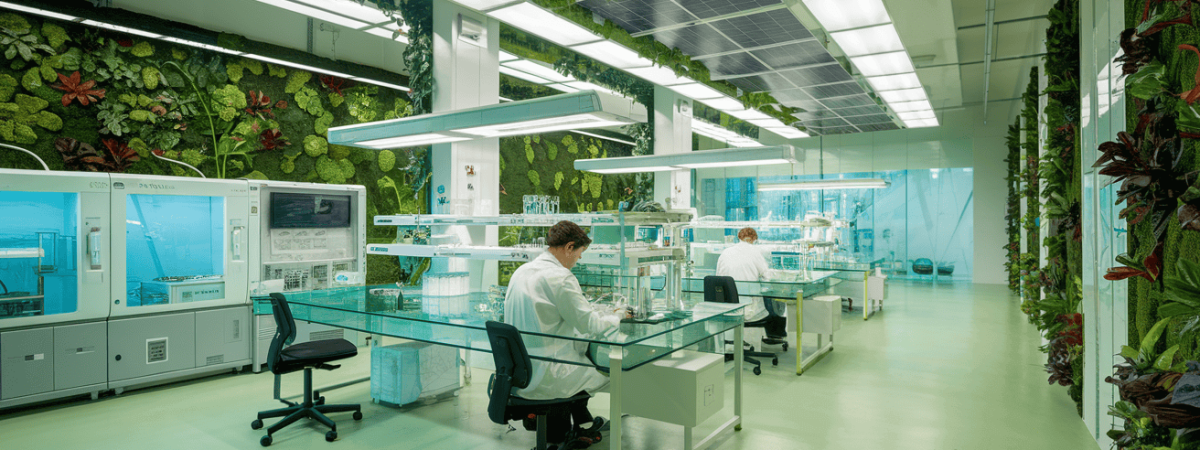Need help? +44 (0) 20 8306 8059
Enhancing Sustainability in Laboratory Operations
The urgency for environmental stewardship has never been more pronounced, particularly in the context of laboratory operations. Renowned for their intensive consumption of resources, laboratories present a unique challenge and opportunity for implementing sustainable practices. This blog delves into the critical need for sustainability in the lab and outlines a strategy grounded in data to foster eco-friendly operations.
Looking at over all resource consumption; it should be imperative to operate sustainable laboratories. Laboratories are quite resource-intensive by nature, consuming significantly more energy and water per square foot than typical commercial buildings. This high demand underscores the necessity for sustainable lab practices that can mitigate environmental impact while also offering financial and operational efficiencies.
It helps to have right strategies for enhancing Lab Sustainability. Sustainable laboratory practices encompass a broad range of initiatives, from energy conservation and water usage reduction to waste management and green chemistry. Below, we explore actionable strategies for lab sustainability, highlighting their impact.
Energy Efficiency:
The adoption of energy-efficient technologies and practices in laboratories can lead to substantial reductions in energy consumption. For example, transitioning to LED lighting and high-efficiency HVAC systems can reduce a lab’s energy use by up to 30%. Moreover, energy-efficient lab equipment not only decreases energy consumption but also minimizes heat output, further reducing cooling requirements. Certain important actionable steps to improve energy efficiency could be to upgrade to Energy Star-rated appliances and instruments, implement occupancy sensors and timers for lighting and equipment and design or retrofit lab spaces to maximize natural light.
Water Conservation:
Water conservation in laboratories can be achieved through several measures, such as installing low-flow fixtures and adopting water-recycling systems. These efforts can reduce water usage by up to 50%, significantly lowering utility costs and conserving a vital resource.
We can achieve some of this by employing water-efficient autoclaves and cooling systems, installing low-flow faucets and showerheads in lab facilities and by considering systems for capturing and reusing greywater.
Chemical Management:
Embracing green chemistry principles can dramatically reduce the generation of hazardous waste. By optimizing chemical reactions to maximize product yield and minimize waste, laboratories can reduce their chemical footprint substantially. Some vital action steps undertaken for it are to conduct risk assessments to identify safer alternatives to hazardous chemicals, optimize protocols to use minimal quantities of chemicals and implement a chemical inventory management system to reduce unnecessary purchases and waste.
Waste Management:
Effective waste management strategies, such as recycling programs and digital documentation, can significantly reduce the volume of waste generated by laboratories. By diverting non-hazardous waste from landfills, labs can achieve up to a 90% reduction in waste disposal. Some best practices to attain this are to introduce comprehensive recycling programs for glass, plastics, and metals, encourage the use of digital records to minimize paper waste and train staff on proper waste segregation to enhance recycling rates.
Sustainable Procurement:
Selecting suppliers and products with a commitment to sustainability can substantially lower a lab’s environmental impact. Sustainable procurement practices encourage the use of recycled materials, reduction of packaging waste, and selection of energy-efficient equipment. Three significant decisions towards this goal are to choose suppliers with recognized environmental certifications, prioritize products with minimal packaging and recyclable materials and to evaluate the lifecycle environmental impact of products, not just the initial purchase price.
The path to a sustainable laboratory is both a necessity and an opportunity. By embracing the strategies outlined above, labs can significantly reduce their environmental footprint, enhance operational efficiency, and lead the way in sustainability efforts. The transition to greener practices is not just about compliance or cost savings; it’s about taking responsible action for the planet’s future.
Ready to transform your laboratory’s impact on the environment? Start your journey toward sustainability today by evaluating your current practices and exploring opportunities for improvement. Together, we can make a difference.





